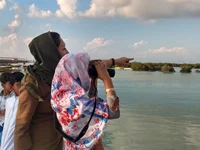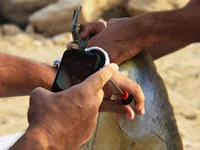Estimating abundance of bottlenose dolphins
Duration: 2017 – 2019
Type: Research + Science-based solutions
Taxon: Cetacean
QECI's Role: Lead Investigator
Sponsors: Local dolphin watching tourism cooperatives of Kandaloo, Shibderaz, and Hengam, and also:



Indo-Pacific bottlenose dolphins (Tursiops aduncus) are widely distributed and abundant in the Persian Gulf, which could be a reflection of their inshore habits. The largest known community of this species within Iranian waters lives in Dolphins’ Bay Natural Heritage Monument, an area of approximately 9,700 hectares lying in the narrow channel between Hengam and Qeshm Islands in the eastern Persian Gulf. The bay is a nationally protected area hosting several threatened and charismatic marine species (e.g. sea turtles, small cetaceans and coral reefs). Since 2003, boat-based dolphin watching tourism activities have commenced in the area, and the bay is now known as the only dolphin watching site in Iranian waters. Consequently, the Indo-Pacific bottlenose dolphins not only play an important role as apex predators in the ecosystem, but also the livelihoods of hundreds of families living in three villages surrounding the bay is tied to their presence.

Although this bottlenose dolphin community, the largest in Iran, suffers from year-round unregulated fishing activities, and very high tourism boat traffic at certain times of the year, no information is available about their abundance, movement patterns and conservation status in the area. Therefore, we have started a series of boat surveys to collect data from dolphins and their interactions with anthropogenic activities (e.g. fisheries and dolphin watching) in the area. The main goals of the project are to:
1) Estimate population size of Indo-Pacific bottlenose dolphins using dorsal fin-based photo-identification technique and capture-recapture model. k
2) Develop a dorsal fin-based photo-Identification catalog, helping to distinguish dolphin individuals living at the Dolphin’s Bay Natural Heritage.
3) Investigate the community structure (e.g. the proportion of females, males, juveniles and calves) and home range of the dolphins.
Thanks to the financial support of the Japan International Cooperation Agency and local boat-based dolphin watching co-operatives, the first phase of this project was successfully carried out at the end 2017, and early 2018. However, to make a comprehensive database, we need to extend our surveys for one more year. Therefore, another small grant can help us to provide a clear insight into the conservation status of the most important known community of Indo-Pacific bottlenose dolphinsalong the Iranian coast.

 Publication
Publication
- Population features and threats to the Indo-Pacific bottlenose dolphins in Iranian Dolphins’ Bay Natural Heritage in the Strait of Hormuz



